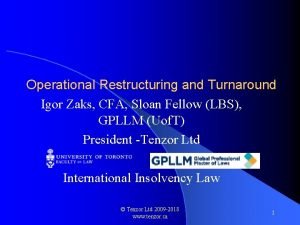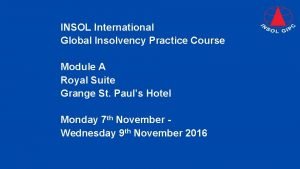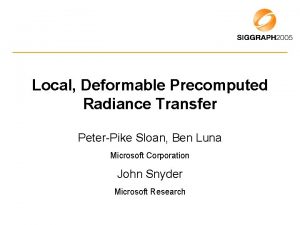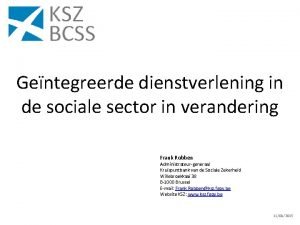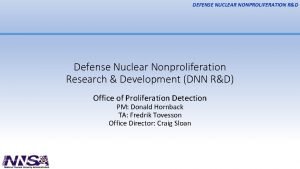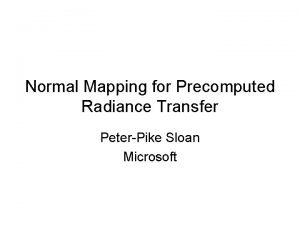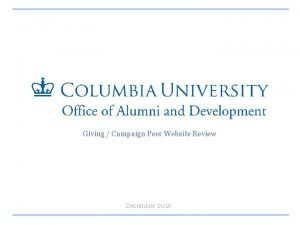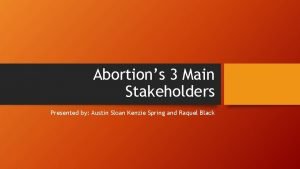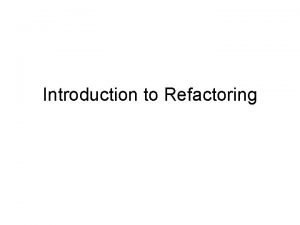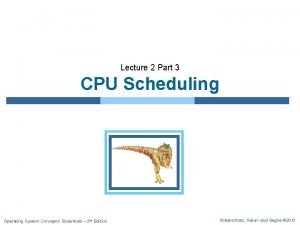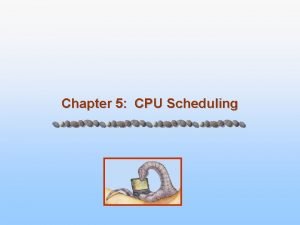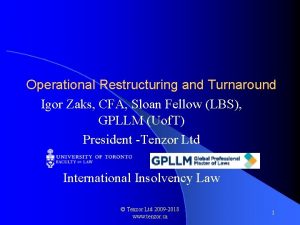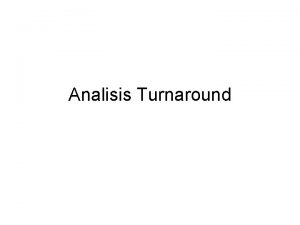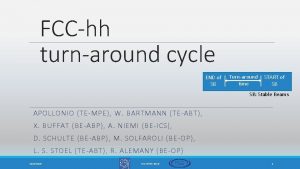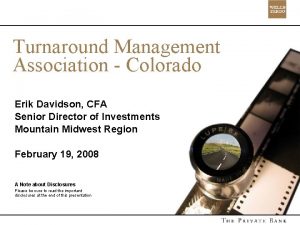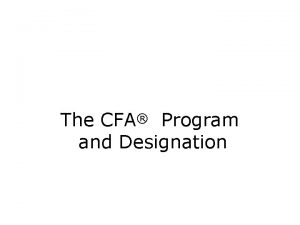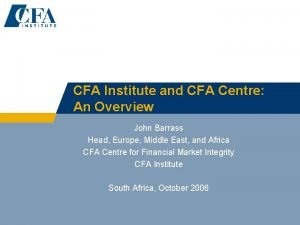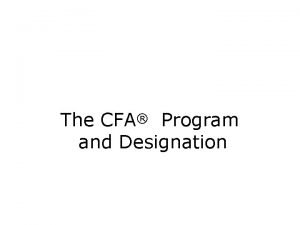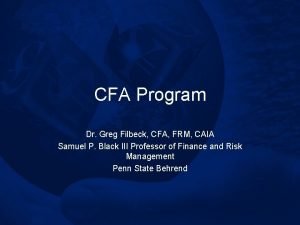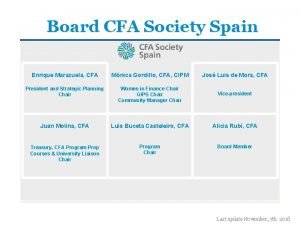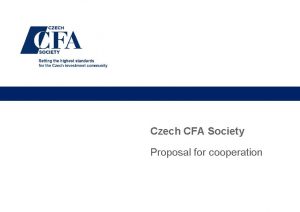Operational Restructuring and Turnaround Igor Zaks CFA Sloan


















- Slides: 18

Operational Restructuring and Turnaround Igor Zaks, CFA, Sloan Fellow (LBS), GPLLM (Uof. T) President -Tenzor Ltd International Insolvency Law © Tenzor Ltd 2009 -2018 www. tenzor. ca 1

Tenzor Ltd. l l l In operation since 2009 Focuses on corporate restructurings and working capital management We work end-to-end: from problem to solution Projects included UK, Europe, US and emerging markets Ukraine, India, Russia, Turkey, Argentina, Hungary, etc. Prior experience in both banking and well-run blue chip company- great mix for turnarounds We also develop AI solutions for working capital and trade/supply chain financing © Tenzor Ltd 2009 -2018 www. tenzor. ca 2

Why Turnaround? Insolvency may be an efficient solution if there are substantial assets in the business (based on actual liquidation value), and they can be easily secured. l Otherwise, one needs to keep the company as going concern as the best way to recover - and this is not only lender’s decision. l To do so, one needs to answer why the company exists and how is it linked to its environment. l Bank lender makes a one-off decision to lend-supply chain partners making their decisions (including granting credit) every time they trade l © Tenzor Ltd 2009 -2018 www. tenzor. ca 3

Five “C’s” of Turnaround l l l Control – Creditors seek to control assets and decision making Capability – The team (existent, new or interim) need to be capable for the task Credibility – Turnaround plan and the team need to have credibility with all stakeholders Clarity – What is the company’s core business, how it fits with the industry structure and does the business model match it Co-operation – Lending group are not the only stakeholders. Ongoing support from suppliers, customers, distributors and others are vital for survival © Tenzor Ltd 2009 -2018 www. tenzor. ca 4

Steps for Distressed Turnaround l Diagnostic – “post deal” due diligence l Fixing the team – Loyalty – Competence – Communication l Re-defining the business l Process optimisation © Tenzor Ltd 2009 -2018 www. tenzor. ca 5

Fixing the Team l Building loyalties l Motivation - not just money l Understanding informal networks l Identifying kick backs, leaks and frauds l Approaches to bringing new people l Making the culture shift © Tenzor Ltd 2009 -2018 www. tenzor. ca 6

Industry structure and Supply Chain l l l Global industry structures changed massively A platform company "Produces nowhere but sells everywhere. . . know where the clients are and what they want and where the producers are. Platform companies then simply organise the ordering by the clients and the delivery by the producers (and the placing of their logo on the product just before delivery). “- Gave. Kal Integrated and collaborative supply chains. Contract manufacturing, outsourcing, muli-tier distribution Changed structures are often ignored by analysts © Tenzor Ltd 2009 -2018 www. tenzor. ca 7

Supply Chain- Distribution of Risk and Reward Component Manufacturers Component Distributors Contract Manufacturers OEM Distributors VARs Customers! • Understanding the supply chain is core to determining the future of the company. • How is wealth and risk distributed? • What is outsourced to whom? Who does financing- is the company a bank? Should it be? • Is the issue overall health of the chain, distribution of rewards and risks at a particular layer or just company specific issues? • Who can “shortcut” the chain and what would be consequences? • Who is going to loose the most if company disappear and what can they contribute to rescue? © Tenzor Ltd 2009 -2018 www. tenzor. ca 8

Working Capital- Good Starting Point Most of the problems of companies manifest themselves in working capital (A/R, Inventories, A/P) l Aged debtor list and its analyses vs. sales: l – Are receivables real? – Is ageing real ? – Why payments are late – disputes vs. credit? – Are sales real? – What happened prior to sale? l Sale is converting inventory to A/R showing a profit. Did it: – Push the problem next level? – Channel overstocking? – Produce uncollectable A/R – Is there actual end user demand? © Tenzor Ltd 2009 -2018 www. tenzor. ca 9

Working Capital Analyses – cont. Analysing late payments allows to uncover issues with quality, logistics, systems, etc. –credit management is the best source of information about the company issues l A/P – Short terms – why terms are not offered? What can be done to regain them? – Long terms –are these sustainable? – Overdues- would these be tolerated? – Key question – are suppliers still supplying or are they already or about to stop? – May be significant cash outflow post acquisition/funding. l © Tenzor Ltd 2009 -2018 www. tenzor. ca 10

Working Capital Analyses- cont l Inventory – Clear distinction between finished goods, components and work in progress – Obsolescence – Components for wrong models? They may be perfectly good but perfectly useless – Is there a process for managing inventories? l Overreliance on ratios - these are just averages – “Good” DSO may be a mixture of prepayments and massive overdue “Good” DIO may be a large pile of useless stuff and a massive shortage of needed inventories – “Good” DPO may be a mixture of pre-paid suppliers and the ones who already stop supply and are looking for legal action – © Tenzor Ltd 2009 -2018 www. tenzor. co. uk 11

CAPEX/ Development Costs l l l EBITDA focus creates a strong incentive to underinvest Company can run on close to zero CAPEX and even maintenance for a while – but this would mean massive cost in the future Cutting R&D improves short term profitability but negatively affects future cash flows. Cutting people improves profitability but in many business this is the main asset. Particularly relevant for industry buyers- often overestimating own ability to develop/support Death by a thousand cuts vs. exit strategy © Tenzor Ltd 2009 -2018 www. tenzor. ca 12

Redesigning the Model Distribution example Credit Insurance? Factoring? Securitisation? What credit limit? purchase Supplier Payment Risks: Distributor credit risk This risk may be highly concentrated Customer credit risk (if distributor has little capital) Product liability (in any case) Sell Distributor Provides: Marketing/Sales Logistics Service Working Capital Finance? Risk mitigation? ? ? © Tenzor Ltd 2009 -2018 www. tenzor. ca Diversified risk? Low concentrations? Single vs. multi tier? How do you finance receivables in EM? 13

Distribution example Credit Insurance easier to obtain? Invoice discounting? Factoring? We are in Developed market! Sell Supplier Provides: Marketing/Sales Logistics Service Collections? Performance risk mitigation? Distributornow agent? Low working capital needs! © Tenzor Ltd 2009 -2018 www. tenzor. ca Diversified risk? Low concentrations? Single vs. multi tier? No need to finance in EM? 14

Rise of ABL l l l Cash flow lending was the main trend in the past. Today, EBITDA is much more volatile- not only reducing multiples, but also making cash flow lending unavailable in many areas. Lending against assets becoming more used, especially where the value can be clearly determined. Illiquid and long term assets are difficult to lend against shorter term is easier. “New Financial Engineering”- how to reduce the risk in transactions Unlike cash flow lending, ABL often requires an understanding of operations © Tenzor Ltd 2009 -2018 www. tenzor. ca 15

Supply Chain and Turnaround Financing The supplier (even a highly distressed one) is a lender, providing the next step in the chain (distributor, manufacturer, end user etc. ) with credit through payment terms (sometimes they are the only or main source of credit). l Buyer of the goods can effectively provide money to the seller through reduced payment terms without taking risk (providing that the supplier fulfilled the contract). l This may provide a workable alternative to DIP (Debtor in Possession) financing, allowing in some cases to provide funds to distressed company without being affected by possible bankruptcy procedures l © Tenzor Ltd 2009 -2018 www. tenzor. ca 16

Key Lessons l l l l Understand the market Do a proper due diligence - do not rely on glossy write ups Understand the industry structure and play it right Build loyal and competent team Ensure stakeholders support Redefine and optimise the business You do not need to be perfect - just be better than competition © Tenzor Ltd 2009 -2018 www. tenzor. ca 17

Thank You and Good Luck! l Igor Zaks (Zax), CFA, Sloan Fellow (London Business School), GPLLM (University of Toronto) l President, Tenzor Ltd. l Tel: +14277772126 l E-Mail: igor. zax@tenzor. ca l Web site: www. tenzor. ca © Tenzor Ltd 2009 -2018 www. tenzor. ca 18
 Igor zaks
Igor zaks Global insolvency practice course
Global insolvency practice course Ldprt
Ldprt Dr lance sloan
Dr lance sloan Mit sloan
Mit sloan Craig sloan nnsa
Craig sloan nnsa Big 5 personality test similar minds
Big 5 personality test similar minds Peter pike sloan
Peter pike sloan Memorial sloan kettering giving pages
Memorial sloan kettering giving pages Jordan sloan
Jordan sloan Dr lance sloan
Dr lance sloan What is corporate restructuring
What is corporate restructuring Refactoring and restructuring methods
Refactoring and restructuring methods Angular diameter turnaround
Angular diameter turnaround Turn around time formula
Turn around time formula Sjf cpu scheduling
Sjf cpu scheduling Keys to divine turnaround
Keys to divine turnaround Turnaround time in os
Turnaround time in os Anatomy of a journey
Anatomy of a journey
